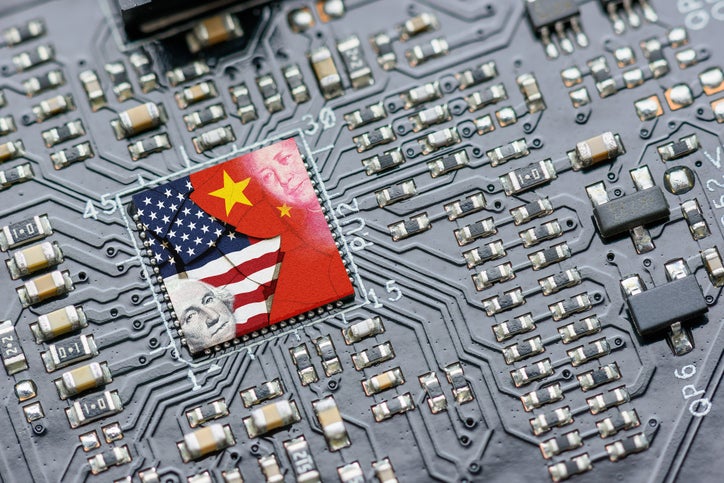
The Biden administration is set to enforce curbs on China’s access to the core pre-trained software of AI systems like ChatGPT in the latest of its continued efforts to block US AI from China and Russia.
However, some experts have questioned how effective these new measures will be as an increasing number of companies develop open source AI models.
The US Commerce Department is considering a new set of regulations to restrict the export of closed source AI models, Reuters reported, citing people familiar with the matter.
Over the past two years, the US has placed a series of blocks on the export of advanced AI equipment to China. The Biden administration has maintained that the curbs are to defend national security and slow China’s military development.
Nvidia, the largest AI chipmaker in the US, saw its revenue decline “significantly following the US Government export control regulations imposed in October”, NVIDIA‘s CFO Colette Kress said in February.
However, in order to continue to sell to China, Nvidia is currently exporting less-powerful versions of its chips that do not require a US licence for export.
How well do you really know your competitors?
Access the most comprehensive Company Profiles on the market, powered by GlobalData. Save hours of research. Gain competitive edge.

Thank you!
Your download email will arrive shortly
Not ready to buy yet? Download a free sample
We are confident about the unique quality of our Company Profiles. However, we want you to make the most beneficial decision for your business, so we offer a free sample that you can download by submitting the below form
By GlobalDataDo open source models make US curbs on closed AI models pointless?
Unlike US chipmakers, the country’s AI leaders creating large language models for GenAI services, such as Microsoft-backed OpenAI and Google DeepMind, are not under any restrictions from the government. This means they can sell to any country in the world without government interference.
The US is concerned that this could lead to adversaries using the software for biological weapons or cyberattacks.
The new US curbs will target China, Russia, North Korea and Iran, according to Reuters, citing sources.
However, GlobalData analyst Josep Bori has questioned how effective targeting only proprietary pre-trained models will be, as the industry appears to be shifting towards open source models.
“The measure only affects proprietary pre-trained models such as those of OpenAI, Alphabet and Anthropic, but the industry appears to be shifting towards open source models, going as far in some cases as to license the internal weights of such models,” Bori told Verdict.
“As such, one has to wonder how effective a measure only affecting proprietary models will be,” he added. “It sort of feels like the genie is out of the bottle with LLM [large language model] technology, and it will be very difficult to control its access.”
In April, technology heavyweight Meta made its latest Llama 3 AI model completely open source, which means anyone can examine and use it.
Google also got closer to open source in February after previously keeping all of its AI development proprietary. The search engine giant said its new family of AI “open models” will be available to experiment with at no cost.
In 2023, Meta and IBM formed an “AI Alliance” that advocates for an “open-science” approach to AI development.
Yann LeCun, Meta’s chief AI scientist, claimed other AI companies like OpenAI had taken part in “massive corporate lobbying” to write specific rules on AI development that would benefit them.
LeCun called for the future of AI development to be open source and available to everyone.
“In a future where AI systems are poised to constitute the repository of all human knowledge and culture, we need the platforms to be open source and freely available so that everyone can contribute to them,” LeCun posted on X.
Will US export curbs lead to an AI bifurcation between East and West?
As the US continues to curb China and other countries’ access to US AI, there are concerns that a bifurcation of AI technology between the two major regions of the world could appear.
Christoph Cemper, CEO of AIPRM, believes that an “East versus West” AI scenario will be detrimental in the grand development of safe AI.
“These models were designed to be helpful, harmless and honest. Severing access or cooperation will only undermine those goals on both sides,” Cemper told Verdict.
“Let’s also not forget that until very recently, all the top AI research was deeply intertwined between countries,” he added. “Dividing it now seems short-sighted when humanity’s challenges require collaboration.”
Cemper also noted that a bifurcated market will make it difficult for companies to carry out business. “Both the US and China are simply too important to ignore, so trade barriers could cripple business plans,” Cemper said.
A new wave of restrictions, on top of the ones affecting the export of semiconductors and advanced equipment, will drive more of a wedge between US and China supply chains.
“Even without considering the risk of a signficant trade war escalation, the current situation is already very challenging to handle both by Chinese and US companies, as their supply chains have long been tightly integrated,” Bori told Verdict.
GlobalData forecasts that the overall AI market will be worth $909bn by 2030, marking a compound annual growth rate (CAGR) of 35% between 2022 and 2030.
With demand for AI chips rising simultaneously from a multitude of industries, the AI chips market alone will be worth £116bn by 2030, according to GlobalData forecasts.
In the GenAI space, revenues are expected to grow from $1.8bn in 2022 to $33bn in 2027, a CAGR of 80%.







